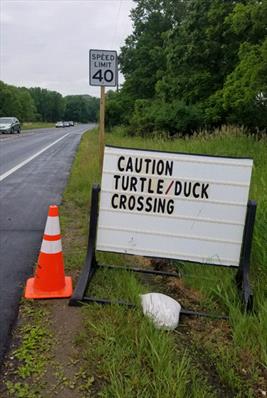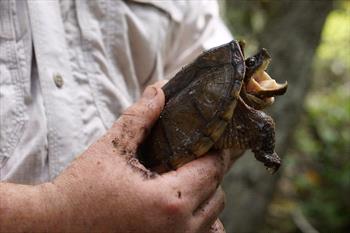Turtle crossing sign

Photo by VIN
"Its guts were hanging out. We had to euthanize it,” said the woman at the wildlife rehabilitation center.
I cried. I’d been out for a lunchtime walk and found an injured turtle. After we got back to work, I drove back to it with a box, picked up the extremely annoyed turtle (who protested being placed in the box by peeing all over it) and drove back to the office. I called the shelter and they sent someone out to get it. I called after work to check on it.
“Thank you for putting it out of its suffering,” I blubbered out. “Thank God,” she said under her breath, knowing I wasn’t going to yell at her.
That was 20 years ago and I still feel the sting of losing a turtle I’d “known” for 15 minutes, although I hopefully abbreviated a long, painful demise.
Turtles still get squashed by cars with gruesome regularity, and the number of times it’s happening is causing their populations to decline. The world loses a large number of turtles and tortoises each year to highway death.
Often Good Samaritans get out of their cars to assist wildlife across the street or highway, during which they either save the turtle, don’t get to the turtle in time, or get hurt or even killed by a car that can’t stop in time. The last time I pulled over to help get a turtle across a street, it wasn’t as busy as it usually is, and cars stopped for me while I ran across the street holding a terrified turtle who likely wondered why he was flying. That time, the help was everything it was intended to be.
A few weeks later I read about a young mother who had stopped to help ducklings cross a road and was killed by a car; thankfully, her toddlers in the car didn’t see it. In the newspaper article about her death, a police officer emphasized that people should not try to move the animals themselves but call the police or animal control for help. He was right about your own safety, but the likelihood is that by the time the police or animal control got there, the imminent danger would be over, one way or another.
The Minnesota Dept. of Natural Resources also says you should not put yourself in danger, and that pulling over and putting on your hazard lights might be enough warning. Or not, as the case may be.
Helping wildlife survive our infrastructure isn’t always effective or safe for the Good Samaritans. Sometimes heartache is involved, the kind in which you wish you had never stopped the car in the first place, or vow never to do again.
Let’s get back to basics. Why did the turtle cross the road?
To get to the Shell station. Bada bing!
They’re slow pokes because they don’t have any need to hurry. As herbivores, they’re not chasing prey – they just move on to another patch of greens. They have hard shells and don’t have typical predators, and unlike rabbits, turtles have built-in protection so they don't need to sprint. Their metabolisms are the opposite of bunnies: they are meant to move slowly, and they’re afraid of anything that moves fast, like cars and people.
Turtles cross the road because they have to travel to a seasonally appropriate spot, so they’re moving between habitats. They’re just going to or from the summer cottage. In late May and June, pregnant females head for familiar and appropriate places to give birth. This time is a common one to spot turtles on roads. Later, new hatchlings get out to find their forever home in waters and ponds. Turtles can travel a lot of miles in a calendar year, and sometimes they’re found pretty far from water, so don’t worry if you find one in a waterless place.
Safety tips:
Snapping turtle

Snapping turtle. Photo by Gary Peeples of U.S. Fish and Wildlife
- If they’re not in danger, don’t help. Stay in your car.
- To pick one up, gently hold it along the shell edge near the middle of its body. Most likely, it will express its fear and displeasure by peeing. You may not be upwind.
- If it’s injured, take it to a wildlife rehabilitator with turtle experience.
- Get it to the other side of the road that it was traveling to, not the same side it was on, or it will just start crossing again immediately.
- It’s easy to think we're “helping” by carrying the turtle beyond the road to the closest bit of water, but the wildlife folks say that’s not the case. I guess it’s like screwing up their GPS systems. Just leave them on the other side of the road and let nature do its thing.
- Don’t pick up a snapping or softshell turtle unless absolutely necessary because they bite. You do not deserve the pain that comes with a bite; experience is a bitter teacher. Picking one up by the tail can injure its spinal cord, so you’ve done harm instead of aiding survival. If you decide to risk picking up a chomping-oriented turtle, grab it by one rear leg while your other hand supports it from below. Better yet, get him on something like cardboard and drag him backwards across the street, as shown in this video. A safer option is to use a branch or shovel to urge it to move. FYI, the snapping turtle is apparently the world’s oldest species. It has not evolved since before the dinosaur age, and it doesn’t like quick movements, which is a good thing given their anatomy.
All of this presumes you are the person putting your behind on the line. Kind souls who love animals will do their best to help without getting themselves hurt, but human safety always comes first, no matter that your adrenalin says otherwise. We have a bigger brain than turtles, so let's use it.
Sadly, there are those among us who are not kind, who do not love animals, and get their kicks out intentionally driving over turtles. Why this is the case I do not know, but it happens regularly and has even been studied, at least informally. Maybe it’s road rage, maybe they’re having the worst day of their life, maybe they’re sociopaths, but sadly it’s not rare and it’s lowering turtle and tortoise populations, including endangered ones.
So, let’s stop crying over turtle demise and move on to doing something to prevent it.
What can you do to assist the declining populations, above and beyond not getting yourself killed?
- Ask your municipality or state department of natural resources for turtle crossing signs, as most people will slow down upon seeing those. Thanks to requests from people on my Nextdoor list, the mayor has placed signs on the highway across which I once carried a turtle to safety (see photo at top).
- Teach others what to do and how to remain safe: educate, educate, educate.
- During breeding season, place some signs yourself as do people having garage sales. They may not last long, but they might save a life or two.
- Contact your local news station and newspaper to cover the topic so more people will be aware.
- Talk about it on Facebook, Twitter, or neighborhood apps such as Nextdoor, so more people will be aware. You can also just talk to someone face to face; even though that’s old fashioned, it's pretty effective.
- Know what a snapping turtle looks like (see photo above). Use a stick to see if it will bite rather than your hand. Be kind, not stupid.
- Check your state's wildlife department for photographs of the types of turtles and tortoises that live there. The more you know about them, the more care you will take for their safety.
Turtle and tortoise habitats are being fragmented, say the Wisconsin DNR folks, and so their populations are dwindling - ditto for around the country. Without them, our ecosystem will shift and the consequences are not fully known. One of them, though, is that later generations will never have the chance to see any turtles.
If we all pitch in with personal awareness campaigns, we can offset some of our chelonian losses. You in?
3 Comments
Nancy
June 23, 2019
Frances Bell
June 22, 2019
David Gjestson
June 19, 2019